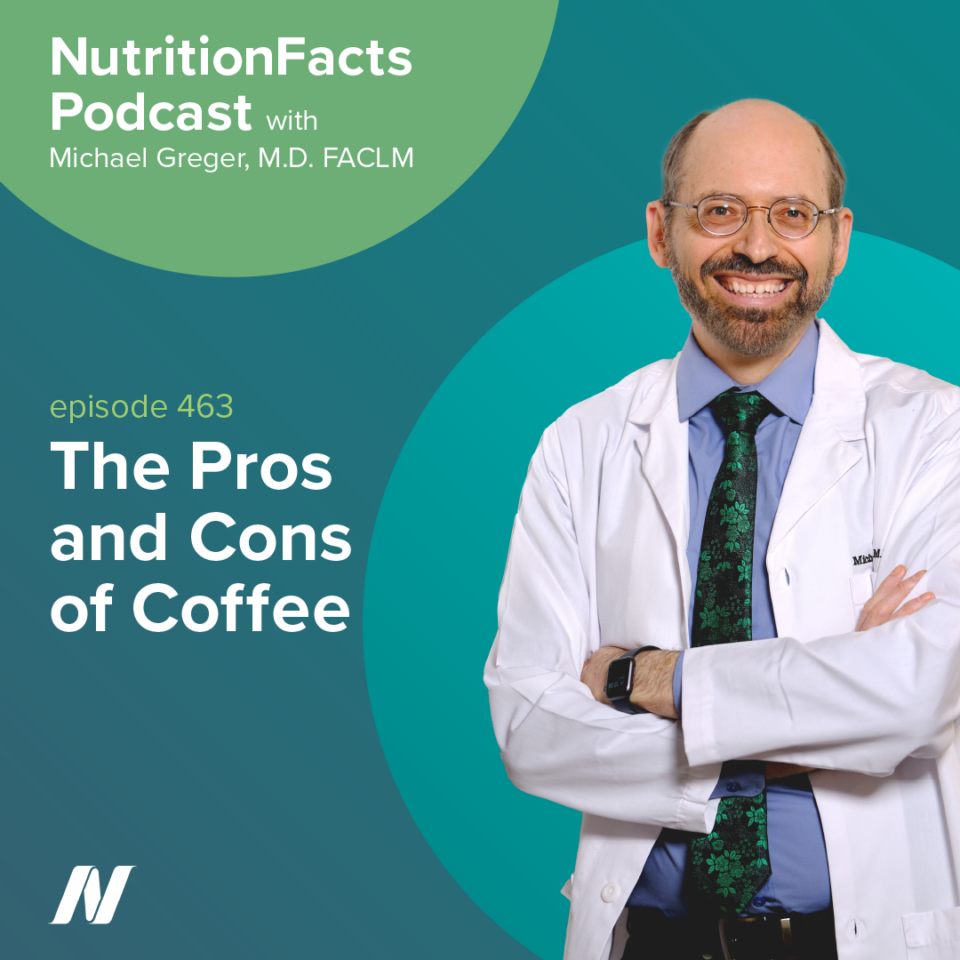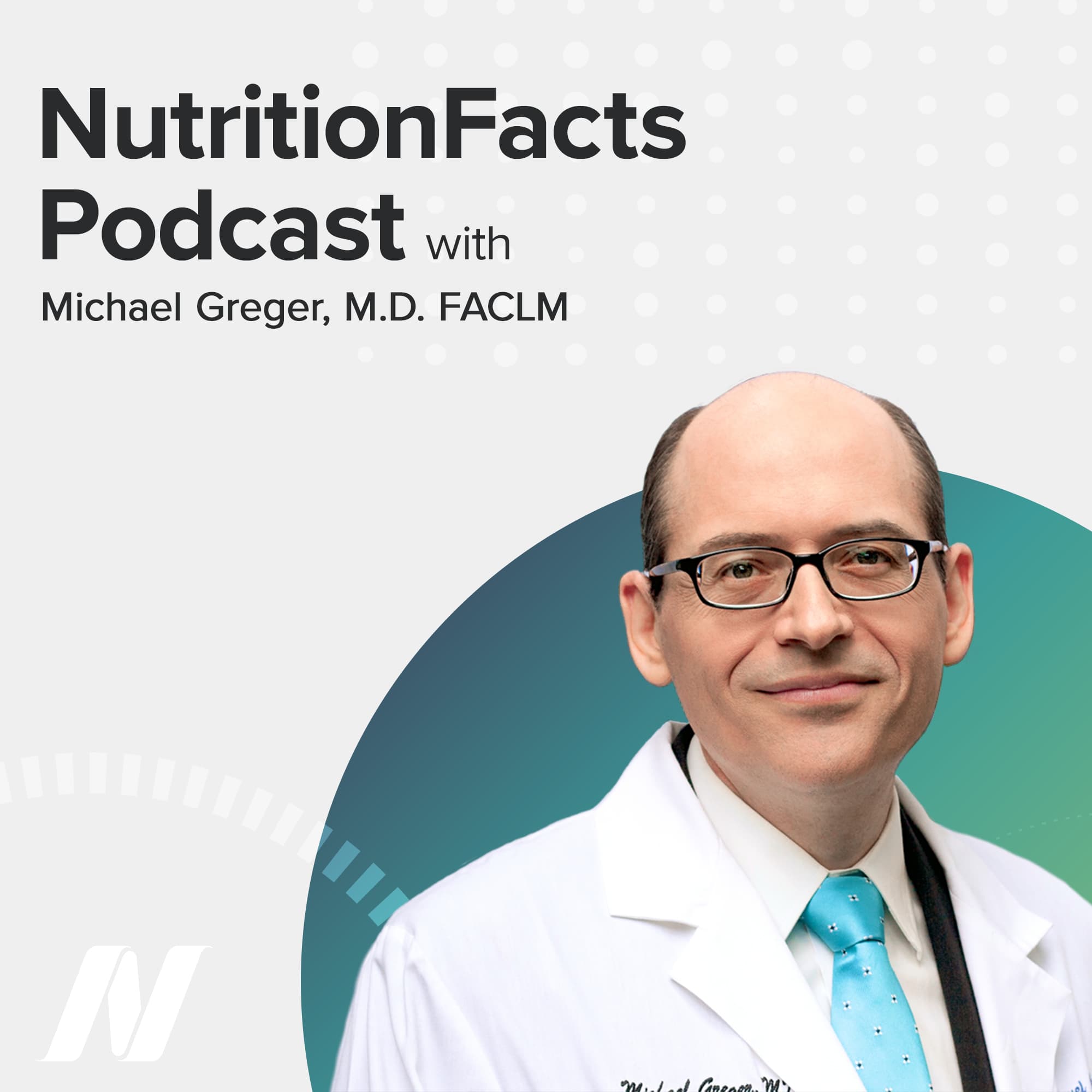Today, we look at some new research on one of our favorite beverages, and we start with how to choose the healthiest coffee.
“[C]offee [may have beneficial effects on] inflammation, lung function, insulin sensitivity, and depression.” This may be in part because of a class of polyphenol phytonutrients found in coffee beans called chlorogenic acids, proven to have favorable effects with studies where they just give it alone in pill form and can show beneficial effects—such as “acute blood pressure-lowering” activity, dropping the top and bottom blood pressure numbers within hours of consumption. Okay, so which coffee has the most? We know how to choose the reddest tomato, the deepest orange sweet potato, since many of the plant pigments are the antioxidants themselves. How do you choose the healthiest coffee?
More than a hundred coffees were tested, and different coffees had different caffeine levels, but the chlorogenic acid levels varied by more than 30-fold. “As a consequence, coffee selection may have a large influence on the potential health potential of coffee intake.” So, all those studies that show that “one cup of coffee” does this or that; what does that even mean when coffee can vary so greatly? Interestingly, “[t]he major contributor to [the] wide range [was the coffee] purchased from Starbucks which had an extremely low [chlorogenic acid] content,” averaging 10 times lower than the others. Maybe it’s because they roast their beans too dark. The more you roast, the less there is. They appear to be partially destroyed by roasting. Caffeine is pretty stable, but a dark roast may wipe out nearly 90% of the chlorogenic acid content of the beans.
The differences between a medium-light roast and a medium roast were not enough, though, to make a difference in total antioxidant status in people’s bloodstreams after drinking them—they both gave about the same boost. Other factors, such as how you prepare it, or decaffeination, don’t appear to have a major effect. What about adding milk?
Longtime fans may remember this ancient video, where the “addition of milk” was shown to prevent the “protective effects of tea” on artery function. Drink black tea, and you get a significant improvement in vascular function within hours, “whereas addition of milk completely blunted the effects of the tea.” Here’s the big boost in artery function you get drinking tea, but drink the same amount of tea with milk, and it’s like you never drank the tea at all. They think it’s the casein to blame—one of the milk proteins binding up the tea phytonutrients. Bottom line, this “finding that the tea-induced improvement in vascular function is completely attenuated after addition of milk may have broad implications on the mode of tea preparation and consumption.” In other words, maybe we should not add milk to tea, or put cream on our berries. Appears to have the same effect on berry phytonutrients, or chocolate—check this out. Eat milk chocolate, and nothing much happens to the antioxidant power of your bloodstream. But eat dark chocolate and get a nice spike within an hour of consumption.
Yeah, but is that just because the milk in milk chocolate crowds out some of the antioxidant-rich cocoa? Milk chocolate may only be like 20% cocoa, whereas a good dark chocolate may be like 70% or more cocoa solids. No, it’s not just that. Here’s how much of this cocoa phytonutrient you get into your bloodstream eating dark chocolate compared to milk chocolate. But, eat that same amount of dark chocolate, but with a glass of milk, and it blocks about half.
Okay, that’s cocoa beans; what about coffee beans? “When milk was added to the coffee [in like a test tube], antioxidant activity decreased” by more than half with just a splash of milk, and down like 95% in a latte, or something with lots of milk.
Okay, but what happens in a test tube doesn’t necessarily happen in a person. You don’t know…until you put it to the test. And indeed, over the course of a day, significantly fewer chlorogenic acids made it into people’s bloodstreams drinking coffee with milk compared to black—cutting absorption by more than half.
What about soy milk? In a test tube, coffee phytonutrients do appear to bind not only to dairy proteins, but also egg and soy proteins. You can see how they did this computer modeling, showing how these coffee compounds can dock inside the nooks and crannies of dairy, egg white, and soy proteins, but what happens in a test tube or computer simulation doesn’t necessarily happen in a person. Eggs haven’t been put to the test; so, we don’t know if having omelets with your black coffee would impair absorption, and neither has soy milk… until now.
Yeah, either way soy milk has some inherent benefits over cow’s milk, but does it have the same nutrient-blocking effects? And the answer is…no. No significant difference in the absorption of coffee phytonutrients drinking coffee black or with soy milk. What seemed to be happening is that the soy proteins do initially bind the coffee compounds up in the small intestine, but then your good bacteria can release them so they can be absorbed down in the lower intestine. So, “considering the reversible nature of binding,” as opposed to the dairy proteins, “it seems not to be as relevant” as to whether or not you add soy milk.
In our next story, we explore why coffee may not be for everyone.
Three-quarters of American adults drink coffee, about half of which on a daily basis. That comes out to a million tons of coffee every year. Might there be “grounds for concern”? Population studies have found that coffee drinkers tend to have lower risk of Parkinson’s, less prostate cancer (especially the women), less liver cancer, less diabetes, liver cirrhosis, depression among women, and a reduction in mortality overall, such that coffee drinkers tend to live longer than non-coffee drinkers, with mortality bottoming out at about four cups a day. But these are all just associations. You don’t know if it’s cause and effect…until you put it to the test.
For example, coffee really does seem to protect the liver. Take people with chronic hepatitis, and have them drink coffee, or not, for a month, then switch them back. And, the coffee really did seem to help. Similarly, randomize Parkinson’s patients to get two cups of coffee’s worth of caffeine and get a significant improvement in movement symptoms within three weeks. Runners randomized to drink coffee shaved about six seconds off their mile. Weightlifters randomized to coffee can squat more weight, about 600 pounds more worth of reps. And, not just athletic performance. A cup of coffee’s worth of caffeine can significantly improve IELT, which stands for “intra-vaginal ejaculation latency time,” from two minutes all the way up to five.
Unfortunately, those effectively randomized at birth to genetically just have a higher predilection to drink coffee do not appear to be protected from diabetes, or depression, or Alzheimer’s, or obesity, or metabolic syndrome. So, it seems the protective associations may just be due to “confounding factors,” like, maybe those who drink coffee just happen to exercise more, or something. And, the same with prostate cancer—no apparent cause-and-effect relationship, and even the mortality benefit seemed to disappear.
Even if a study did show coffee drinking could extend lifespan by reducing inflammation, or improving lung function or insulin sensitivity, that would mean on average. There is “interindividual variability…after consumption of major plant-food…compounds,” meaning people may respond differently. For example, how crazy is this? “In some [rare] individuals,…heavy use of caffeine apparently provokes sleepiness.” That’s an extreme example. Most of the time, it’s just that “some individuals may benefit more than others from the health effects of [different foods].” For example, because of differences in gut bacteria, only a minority of Westerners may derive extra benefit from soy, as I’ve described before. The most common difference in caffeine effects is that while most people metabolize caffeine rapidly, certain gene variants in liver detox enzymes make some people slow metabolizers. Might that make a difference?
Well, habitual coffee consumption of at least three cups a day has been “associated with uncontrolled [blood pressure]” among older individuals diagnosed with hypertension, suggesting that “moderating coffee intake” may be a good idea for some people. But, even if it was cause-and-effect, that would be on average. What would happen if you split people up by how fast they metabolize caffeine? Compared to coffee abstainers, those who have impaired caffeine metabolism genes have an elevated risk of becoming hypertensive at one to three cups a day, and especially at four or more. Okay, but check this out. For the rapid metabolizers, not only was there no excess risk at one to three cups, heavy coffee drinkers were protected, meaning apparently the more coffee they drank, the lower their risk. How do we explain that?
“Coffee is a complex ‘blend’ of a vast number of different [compounds].” There are protective polyphenol antioxidants that are beneficial. Coffee beans are, after all, beans; well, actually, seeds—but seeds are really healthy too! On the other hand, there’s the caffeine, which can spike adrenaline levels in the blood—but only if you’re a slow metabolizer. Rapid metabolizers can clear caffeine so fast that there’s no increase in adrenaline even at four or more cups a day. And so, then you just have the beneficial polyphenols that actually lower your blood pressure—hence the benefit overall. “Thus, there seems to be a Jekyll and Hyde aspect to coffee, whose overall action on the cardiovascular system appears to be regulated by” that gene for the enzyme that metabolizes caffeine.
“The important question,” though is, “Does it give women larger breasts?” W-w-hat?! Young women who drink a lot of coffee and are rapid caffeine metabolizers have about a half-a-baseball-sized larger breast volume, which may be a bad thing, “as breast volume is associated with breast cancer risk.” But no, the important question is, “What about heart attack risk?” In slow metabolizers, daily coffee consumption appeared to double the odds of a heart attack, or even quadruple the odds at four cups a day, whereas in the rapid caffeine metabolizers, daily coffee consumption was protective, cutting the odds of heart attack by more than half—or at least until you get up to four or more cups a day. “The protective effects observed among rapid metabolizers suggest that the efficient elimination of caffeine might have unmasked the protective effects of other [phyto]chemicals in coffee.”
We think it may be the adrenaline again, since if you’re a slow metabolizer of adrenaline, high coffee consumption may put you at risk as well.
So, is coffee “friend or foe”? “[T]hese studies suggest the possibility that slow caffeine metabolizers who consume caffeinated coffee may have an increased risk of [cardiovascular disease], whereas fast caffeine metabolizers may be protected from this risk by the antioxidants and other beneficial compounds present.”

 Previous Podcast
Previous Podcast Next Podcast
Next Podcast